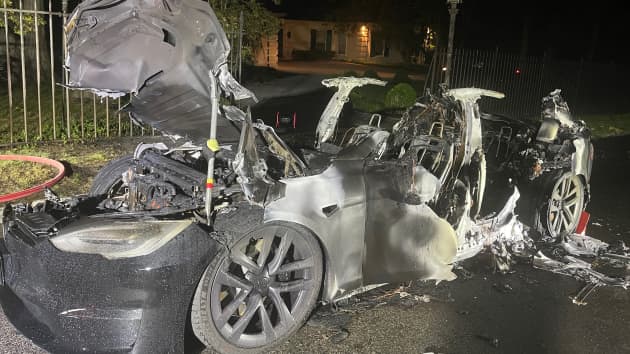|
Politics Forum
|
List All Forums | About |
|
|

Photo From: Tom Hemmick - Album: No Album
Description: A tragic ending.
Seems there's plenty of elec vehicle promotional materials, by the mfgrs. as well as the govt greenies. Citing the Pros but leaving out the Cons. Jim Matthews has posted some of the promotional information.
Here's my reply:
Seems there's plenty of elec vehicle promotional materials, by the mfgrs. as well as the govt greenies. Citing the Pros but leaving out the Cons.
There's an absence of explaining how the EV battery fires are much hotter burning and are more intense, are much more difficult to extinguish, than ordinary IC vehicle fires. And the EV's are known to reignite both soon after extinguishing, and reigniting in the hours or even the days later. They pose new risks to first responders.
However, other sources have been explaining the reasons how EV fires are quite nasty. Here's some quotes, examples of the problems.
> March 2018 Fire extinguished but reignited in the tow yard 5 days later. [Tesla X]
> May 2018 Fire extinguished but reignited while loading on tow truck and again reignited in the tow yard [Tesla S]
> Dec 2018 Fire started in workshop parking lot, then reignited twice. [Tesla S]
> Risk of reignition leads to recommending that damaged EVs should be stored within a 50-foot clear radius area.
> Nov 2020 NTSB report: lithium-ion batteries pose the risk of electric shock to emergency responders from exposure to the high-voltage components of a damaged lithium-ion battery.
> further risk is that damaged cells in the battery can experience rapid and uncontrolled increases in temperature and pressure (thermal runaway), which can lead to hazards such as battery reignition/fire.
> A major concern with the large battery systems used in EVs is that the thermal runaway of one cell can lead to a catastrophic fire in the whole battery system and re-ignitions even after visual flames have been extinguished.
< The problem with EV lithium-ion batteries is the chemistry, which is different from earlier nickel-metal hydride hybrid batteries.
> fumes from a burning lithium fire are highly toxic, capable of causing death or long term brain injuries.
> Lithium burns at 2000C / 3632F – more than hot enough to melt steel.
(underlines added)
A similar problem has occurred in a large Tesla Megapack installation designed to serve the power grid in South Australia. One of the lithium Megapack battery banks caught fire and burned for about 3 days.
Uploaded: 12/31/2021 by Tom Hemmick
Comments on this Image: You must be registered user and logged in to comment.
Login or Register and you will be returned to this image page.
|
(5/10/2022) Jim Matthews wrote:
Fire incidents are ~11x lower for Tesla vehicles than the average vehicle in the U.S., which is the result of hard work. The manufacturer continues to improve battery chemistry, cell structure, battery pack structure, and vehicle passive safety in order to decrease fire risk to as close to zero as possible. We have all come across articles in the media that have covered the fires of electric vehicles (EVs), however, the problem of fire incidents in cars with an internal combustion engine is not so often covered. This is probably due to the fact that the topic of EV fires attracts a lot of attention, which means such articles will receive more clicks. And as such, it has become a game of generating clicks over presenting the full story. Unfortunately, this creates an opinion among readers that EVs are more at risk of fire, which is completely untrue. The reality is that, compared to Tesla vehicles, ICE vehicles catch fire much more frequently. According to the latest available data, there were almost 173,000 ICE vehicle fires in the U.S. alone in 2020. According to a new report released by Tesla, the number of fires for its vehicles is about 11 times lower than for the average car in the U.S. From 2012 to 2021, for every 1 billion miles driven, there were approximately five Tesla vehicle fires. By comparison, data from the National Fire Protection Association (NFPA) and the U.S. Department of Transportation show that there are 53 ICE vehicle fires for every 1 billion miles driven in the U.S. The difference between the indicators is very significant. Note that in order to provide a suitable comparison with the NFPA data, the Tesla data set includes vehicle fires caused by structure fires, arson, and other reasons unrelated to the vehicle, which account for some of the Tesla vehicle fires over this time period. Therefore, the actual fires of the manufacturer's vehicles are far fewer. These results are the result of Tesla's hard work, which continuously is dedicated to improving the safety of its vehicles at all levels. The manufacturer continues to improve battery chemistry, cell structure, battery pack structure, and vehicle passive safety in order to decrease fire risk to as close to zero as possible. With Tesla's technology relentlessly improving, its EVs will be even less likely to catch fire in the future. |
